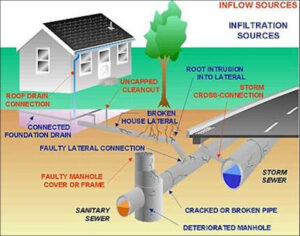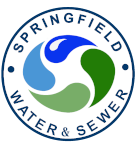 Stormwater flowing into a municipality’s sewer system through low gully traps, illegal connections, broken pipes, and unsealed manholes can cause overflows, system strains, and interruptions in your sewer operations. This is known as Inflow and Infiltration; aka I&I.
Stormwater flowing into a municipality’s sewer system through low gully traps, illegal connections, broken pipes, and unsealed manholes can cause overflows, system strains, and interruptions in your sewer operations. This is known as Inflow and Infiltration; aka I&I.
Why bother to fix Inflow & Infiltration?
By identifying I&I early and reducing their levels, municipalities can benefit from:
- Reduced localized overflows: Through the management of overflows from manholes during rainfall, controlled overflow points, pump stations, and treatment plants.
- Improve operational efficiencies: I&I reduces the sewer system capacity, limiting the potential for growth within a specific catchment.
- Reduced ongoing costs: I&I results in clear water being pumped and treated along with wastewater, contributing to increased costs.
How to identify whether you have an I&I problem
Councils and water authorities can identify whether they have existing I&I issues within their system by looking for these indicators:
- Pumps run for hours and inflows increase significantly during storm events
- The hydraulic loading of wastewater treatment plants increases significantly after a rain event
- Localized overflows occur within a collection system during a heavy storm event
- An increase in inflow during dry weather conditions compared to previous months
Steps to reduce I&I within your wastewater system
First, identify the general vicinity of the issue through flow monitoring. Then identify the exact problem, locate the area(s) where it is occurring, and introduce measures to improve the situation.
The following steps provide a simple overview of an I&I reduction plan that can assist in identifying various stages associated with reducing I&I in a wastewater system:
- Targeted monitoring – monitoring wastewater flows within the system
- Identifying the problem – is it inflow or infiltration?
- Source detection – where is it occurring within the system?
- Rehabilitation – what can be done to reduce or eliminate the problem(s)?
Source detection
A few ways to detect the sources of I&I include:
Private Inspections – after receiving and documenting permission from property owners, inspecting private properties consists of visual assessments of the stormwater and wastewater networks within a property. Illegal connections could mean that a stormwater down pipe is directly connected to a wastewater gully trap.
Manhole Inspection – Manhole inspections can identify leaks from broken pipes, and joints due to tree root intrusion or design issues. Manholes can contribute to significant I&I through leaky covers as well.
Smoke Testing – Smoke testing locates I&I sources by identifying stormwater drain cross connections, broken pipes, and laterals, or unsealed manholes.
Dye Testing – Dye testing can be used to identify leaks and confirm smoke test results. The method uses water mixed with a non-toxic dye. The colored water Is pumped through the ground and storm water system and appears in the sanitary sewer collection system where leaks and illegal connections occur.
CCTV (closed circuit television) cameras – CCTV allows authorities to visualize the inside of pipes by using a small camera that travels down the length of a pipe to produce a visual representation of its condition. CCTV inspections can reveal the need for rehabilitating leaky pipes, facilitate grease or root removal, identify improper taps into the municipal lines, or find broken lateral connections.
Rehabilitation of Wastewater systems
Rehabilitation can include, but is not limited to, the following:
- Seal manholes and replace leaky covers
- Use cured-in-place piping (CIPP), trenchless rehabilitation or chemical grouting to seal leaks, and open cut replacement pipes
- Raise gully traps and disconnect stormwater downpipes from the gully trap and redirect into stormwater systems
- Fix broken laterals (reline or replace); fix any other private connections which might be improperly or illegally tapped into the municipal system

